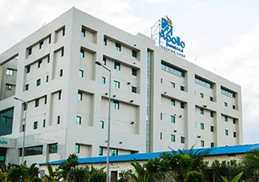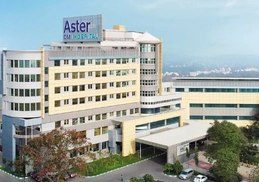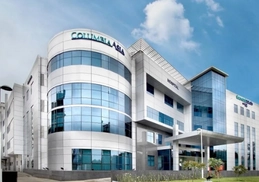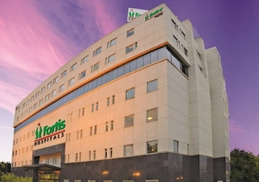
+91 8095511877

+91 8095511877
A TMJ surgery helps to correct Temporomandibular joint disorders. If you have a TMJ disorder, you will have pain in the lower jaw area. As it progresses, you will find it difficult to open your mouth. Medicines may help you to control pain and improve jaw movements.
TMJ exercises and correcting the way you chew will also help. But if the symptoms get too severe, your doctor may recommend a TMJ surgery.
The TMJ or temporomandibular joint connects your lower jaw to the skull. Articular disc placed in between the bones acts as a cushion to help in smooth movements of your jaw. Muscles and ligaments help to stabilize the joint and aid in jaw movements.
There are two TMJs in either side of your face. It is a hinge joint that allows you to move the lower jaw up and down. Also, both the joints work together to move your lower jaw.
You can have a TMJ disorder due to several reasons. Some are due to degeneration of the joint, while others may be due to your habits. If you have habits like clenching of the jaws and grinding of teeth, you are at risk of TMJ issues.
Similarly, wear and tear of the articular disc due to overuse and conditions like arthritis will also damage the joint.
Continuous pain in the joint is the most prominent symptom of a TMJ disorder. Stiffness of the jaw is another. If medications, exercises, and occlusal splits do not help, the only option before you is to have a TMJ surgery.
You can have a TMJ problem due to the following reasons
Certain factors increase your risk of a TMJ disorder. Some of them are
Certain diseases can also lead to TMJ problems the common ones are
But you can have a TMJ disorder even if you are not at risk.
The symptoms affect either one or both sides of your face. The common symptoms include
Some other symptoms are
There are different treatments for TMJ disorders. They are
You will have a TMJ surgery if other treatment methods fail to give the desired results. Medications and physical therapy are the two standard methods.
But, if you do not get any relief with these or the symptoms become more severe, you will need a surgery
There are three different types of surgical techniques for correcting TMJ disorders.
1. Arthrocentesis – It is a minimally invasive surgery. In this, the surgeon uses normal saline to wash the joint area and remove the mediators of pain and inflammation.
Arthrocentesis is an ideal treatment for TMJ disorders that occur due to the derangement of the articular disc responsible for smooth movements of the joint.
You will have general anesthesia during the procedure, which makes it painless. The surgeon will then insert two needles into the joint space. One will have saline to wash the area, and the other is for removing metabolic waste products responsible for pain and inflammation.
The treatment is not possible in those with infections in the joint area.
The common complications include
The procedure gives long-term pain relief in some, while in others the effects will be temporary
2. Arthroscopic TMJ surgery
It is a minimally invasive surgery to correct TMJ disorders due to
You will have general anesthesia during the surgery. Once you are asleep, the surgeon will make two small incisions in front of your ear.
Through one of the incisions, the surgeon will pass a cannula, which is a hollow tube. He or she will then insert a small camera through it to view the joint from inside.
The camera will start transmitting images to a monitor. The surgeon will then insert surgical instruments through the other to carry out the surgery by viewing the joint in a monitor.
Since the surgery has only two small incisions, your recovery will be faster than open surgery. Post-operative complications will also be fewer.
3. Open TMJ surgery
If the surgeon feels that arthroscopic surgery will not help you, the only option left is open surgery.
You will have general anesthesia during the surgery. The surgeon will then make an incision close to the ear to expose the joint.
If there is a dislocation of the disc, the surgeon will put it back to its position. In some situations, the disc will be worn out and beyond repair.
Then the surgeon will remove the disc and place an artificial disc in its position. It will help to improve the movements in the jaw. Once this is complete, the surgeon will place sutures to close the incision.
For a day or two after the surgery, you will have some pain in the joint. Painkillers will help to control it. You will need to keep icepacks over the joint to reduce the swelling.
For the first two weeks after surgery, you will find it very difficult to open your mouth. The doctor will prescribe some exercises to ease the movements of the jaw.
After three or four weeks, the pain in joints will go off. You will also find it easier to open your mouth than before.
Some of the complications are
Most of those who have TMJ surgery get good relief from the symptoms. Long-term pain relief and improvement in jaw movements are the main benefits. In some, the operation may give little relief, or the benefits will be temporary


This article has been reviewed for medical correctness and relevance by
Dr Faizal CP
Dr FAIZAL CP is a consultant Pedodontist also working as Professor & Head , Dept of Pediatric & Preventive Dentistry , Kannur Dental College, Kerala, India. He has more than 18 years of academic experience and has published more than 50 scientific articles in indexed journals . His areas of interest are dental traumatology , pediatric endodontics and dental materials

Juma Rasheed
Oman


Apollo Chennai

Apollo Indraprastha

Aster CMI

Columbia Asia

Fortis Bangalore

Fortis Memorial Research Institute(FMRI)
Frequently Asked Questions
Is there surgery for TMJ?
What doctor does TMJ surgery?
What happens if TMJ is left untreated?